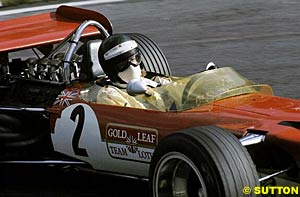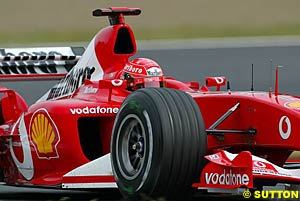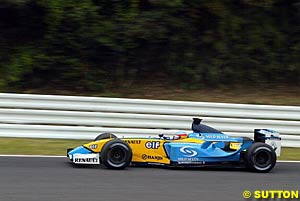
Atlas F1 Magazine Writers
With a month gone since the end of the 2003 season and some four months left before the 2004 season begins, the countdown to the Australian Grand Prix is running strong. However, this is Formula One, and behind every number there is always a story - so every day until the race in Melbourne, Atlas F1 will bring the numbers and the story behind them... Don't forget to check this page for a new addition every day!
Elio de Angelis drove the first of his 108 races at the 1979 Argentinean Grand Prix for the Shadow team. It was an impressive debut race. The Italian outqualified fellow rookie teammate Jan Lammers by a full second and after starting from 16th on the grid he was eleventh after the first lap. Eventually de Angelis finished seventh.
1983 was downright horrible for de Angelis. He started the season by being disqualified at Brazil after having qualified with the new Renault-powered Lotus and driving the race in the old Ford powered car. After that the new car let him down time and again throughout the season. However, things turned around during the next two seasons with the Renault power, where de Angelis finished most races in the points.
The 1985 San Marino Grand Prix gave him his second win under very difficult circumstances. The turbo boost went on and off on its own and in the final laps the Lotus's brakes malfunctioned. However, whereas the large majority of the drivers had extreme problems in reaching the finish on their fuel load, de Angelis was the only driver to reach the full 60 laps.
For 1986 Elio moved to Brabham. The ultra flat BT55 was inovative, but dangerous. After four races in the season, the team went testing at the Paul Ricard circuit in Southern France. After a rear wing failure, de Angelis crashed and as a result of lacking safety measures died in hospital. He was 28 years old.
Rindt scored his first points in the 1965 German Grand Prix, where he finished fourth. But most of his success came five years later, in the 1970 season, prior to his fatal accident at Monza. With only his five wins as points-scoring finishes that year, even a strong final push by Jackie Ickx could not rob Rindt of the World Championship in the end. Exactly 50 days after his untimely death, Jochen Rindt became World Champion.
Nobody has led more races than Michael Schumacher. Currently, the Ferrari driver has led in 110 of the 193 races he started.
In 1993 Schumacher led in two races, retiring from the lead in Monaco and winning in Portugal. Then, in 1994, Schumacher and Benetton put together the perfect package and the German led in no less than 13 races. This record was only improved in 1995, his last year with Benetton. Schumacher led 14 races to claim his second World Championship.
The next year, his first at Ferrari, was clearly a step back. The World Champion only led in five races. By 1997, though, he lead in twelve races, followed by another 15 in each of the two years that followed. From 2000 onwards it was complete domination for the German. With 14 races lead in 2000 and 13 in 2001, he broke Ayrton Senna's record of 86 races led. Another 13 races in 2002 put him over the 100 mark. In 2003 Schumacher relapsed, but the Ferrari driver still lead in eight races to rise his total to 110.
While Ferrari, Williams and McLaren had most of the focus in 2003, the Renault team also had its share of success. With a total of 111 laps led in the season, the French team was the only one that could seriously attack the traditional top three teams.
In his home Grand Prix, Alonso led again, albeit for just two laps before his second pitstop, but the crowd went crazy nonetheless. In Monaco, it was Jarno Trulli's turn to lead a few laps before pitting, but in Canada it was Alonso again. The young driver now led twice, before both his pitstops.
In Britain, Jarno Trulli grabbed the lead from pole-sitter Rubens Barrichello right at the start, but unfortunately for the Italian two safety car periods meant he could not build a lead and eventually lost his lead when pitting.
During the next race in Germany, Alonso led for a single lap, again before making his pitstop. However, in Hungary, there finally was a lead that lasted. In a superb race, Alonso led all but one lap and scored his first Formula One victory - to become the youngest F1 winner in the World Championship's history.
Since Clay Regazzoni's win in the 1979 British Grand Prix, Williams have collected no less than 112 Formula One victories. This places the team third behind only Ferrari (167) and McLaren (137).
When Nigel Mansell returned in 1991, things really started rolling. With seven victories in that year - two of which were scored by Riccardo Patrese - it was the start of the third and more succesfull era. The dominance of Williams in 1992 was demonstrated by the ten wins the team scored on their way to the Championship.
With an all new driver duo of Alain Prost and Damon Hill, Williams scored ten wins in 1993, followed by seven in 1994 and five in 1995. By 1996, the team set a personal best - with 12 wins in total scored by Hill and rookie teammate Jacques Villeneuve. The latter, teamed up with Heinz Harald Frentzen, brought Williams eight more wins in 1997 - and then it all stopped.
Without a competitive engine for two years - and then a new engine partner, BMW, going through its teething stage, Williams remained win-less for three full seasons. In 2001, however, they were back to the top of the podium with German Ralf Schumacher and Colombian Juan Pablo Montoya behind the wheel. Four wins in 2001, one in 2002 and another four in 2003 marked the fourth era for Williams - and there's every reason to believe it will continue next year.
The 113th Formula One World Championship Grand Prix was held in Belgium in 1963.
However, amidst all that brilliant display at Spa-Francorchamps, a very young driver took the start of a World Championship race for the first time in his career. After only having practiced at Monaco, Chris Amon made his official race debut in Belgium. And, just under twenty years old, he was the second youngest driver to make his Grand Prix debut at that time. Only Mexican Ricardo Rodriguez debuted at a younger age before Amon did.
Amon's debut race looked promising but ended prematurely. After starting from 15th, the Kiwi quickly made his way up through the field, climbing to tenth after the first lap and slowly making his way into the top six. However, while running in sixth, Amon suffered an oil leak and was forced to retire from his first Formula One race.
The McLaren team have a tally of 114 Pole Positions, ranking third to Ferrari (166) and Williams (123).
Thereafter, it wasn't until the 1984 Monaco Grand Prix that a McLaren driver started from pole position again. With seven more poles in three years, McLaren were back on the map and by 1988 the counter really started increasing. Helped by a very superior car and line up, McLaren started from the front of the grid 15 out of 16 times in 1988, Ayrton Senna taking 13 Poles and Alain Prost two.
Up until 1991 the rain of poles continued with Senna claiming no less than 44 pole positions in four seasons. When McLaren's superiority faded after 1991, Senna added two more in 1992 and 1993. After that McLaren entered another period in which they didn't start from the front of the grid. Only when Mika Hakkinen started from pole in the 1997 Luxembourg Grand Prix, the second pole-less era ended.
Since then, the Flying Finn scored 25 poles for McLaren, while David Coulthard added seven and Kimi Raikkonen two.
In 1997, the younger Schumacher brother made his Formula One debut with the Jordan team. His first season was one of mixed fortunes, as many retirements and flashes of brilliance took turns. For 1998, the German remained with Jordan, only missing out on his first win at Spa-Francorchamps because the team ordered him to keep station behind a slower Damon Hill. After that season Schumacher made the move to his current team, Williams.
In a strong 1999 season Ralf managed no less than eight podium finishes to claim sixth in the Championship. 2000 was the first year with the BMW engine in the Williams, which seriously dropped the reliability of the German's car. The problems continued the next season. However, as the package got stronger, Schumacher also scored the first win of his career, at Imola. Two more wins followed, resulting in a fourth place in the 2001 Championship.
While Ralf won only one race in 2002, the supreme reliability of the Williams kept the points flowing in. Finally, the 2003 season gave Ralf two more victories, but a disappointing end of the season saw him end only fifth in the World Drivers standings.

 The year after de Angelis moved to Lotus, where he scored a second place in the Brazilian Grand Prix. In 1981 the Italian remained with Lotus, where a much more reliable car gave him eight point-finishes. The next season the car was faster, but less reliable again. However, de Angelis did score his first victory in Austria. After seeing both Riccardo Patrese and Alain Prost retire from the lead, the Lotus driver fought a close battle with Williams driver Keke Rosberg, beating the Finn by five hundreds of a second.
The year after de Angelis moved to Lotus, where he scored a second place in the Brazilian Grand Prix. In 1981 the Italian remained with Lotus, where a much more reliable car gave him eight point-finishes. The next season the car was faster, but less reliable again. However, de Angelis did score his first victory in Austria. After seeing both Riccardo Patrese and Alain Prost retire from the lead, the Lotus driver fought a close battle with Williams driver Keke Rosberg, beating the Finn by five hundreds of a second.

 The career of Jochen Rindt was unique in many ways. He was the first Austrian to drive in Formula One and he was the only driver to become World Champion posthumously. Moreover, of his 52 World Championship races, Rindt finished only 19 times. But it attests to his enormous talent that in only four of those races the Austrian didn't score any points. With six wins, three second places, four thirds, six fourths, a fifth and a sixth place, Rindt scored 109 points.
The career of Jochen Rindt was unique in many ways. He was the first Austrian to drive in Formula One and he was the only driver to become World Champion posthumously. Moreover, of his 52 World Championship races, Rindt finished only 19 times. But it attests to his enormous talent that in only four of those races the Austrian didn't score any points. With six wins, three second places, four thirds, six fourths, a fifth and a sixth place, Rindt scored 109 points.

 The impressive series started with the 1992 Belgian Grand Prix, exactly a year after Schumacher made his Formula One debut. In drying conditions, the then Benetton driver pitted at the right moment, taking the lead eleven laps from the end to take his first victory.
The impressive series started with the 1992 Belgian Grand Prix, exactly a year after Schumacher made his Formula One debut. In drying conditions, the then Benetton driver pitted at the right moment, taking the lead eleven laps from the end to take his first victory.

 Fernando Alonso was the first driver in a Renault chassis to lead a race since Patrick Tambay led the 1984 Italian Grand Prix. In Malaysia, the young Spaniard scored a sensational pole position and led the race until his first pitstop.
Fernando Alonso was the first driver in a Renault chassis to lead a race since Patrick Tambay led the 1984 Italian Grand Prix. In Malaysia, the young Spaniard scored a sensational pole position and led the race until his first pitstop.

 Williams's Grand Prix victories came in roughy four eras. The first period was between 1979 and 1981, in which Australian Alan Jones was the main contributor for Williams's tally, scoring 11 wins. After that came three years in which Keke Rosberg won a race each year. 1985 was the dawn of the second era, where both Rosberg and Nigel Mansell took two victories. In 1986 and 1987, the much discussed line up of Nigel Mansell and Nelson Piquet fought furious battles, which brought the team 18 more victories.
Williams's Grand Prix victories came in roughy four eras. The first period was between 1979 and 1981, in which Australian Alan Jones was the main contributor for Williams's tally, scoring 11 wins. After that came three years in which Keke Rosberg won a race each year. 1985 was the dawn of the second era, where both Rosberg and Nigel Mansell took two victories. In 1986 and 1987, the much discussed line up of Nigel Mansell and Nelson Piquet fought furious battles, which brought the team 18 more victories.

 In a very wet race, Jim Clark scored his fourth career win with a stunning display of dominance. The Lotus driver started from eighth on the grid but immediately took the lead and never looked back. By the end of the race, Clark had a lead of almost five minutes over number two Bruce McLaren and lapped the rest of the field. It was Clark's first win of his best season. The Scotsman would continue to win six more times in the following eight rounds.
In a very wet race, Jim Clark scored his fourth career win with a stunning display of dominance. The Lotus driver started from eighth on the grid but immediately took the lead and never looked back. By the end of the race, Clark had a lead of almost five minutes over number two Bruce McLaren and lapped the rest of the field. It was Clark's first win of his best season. The Scotsman would continue to win six more times in the following eight rounds.

 The first Pole came when Pete Revson qualified fastest at the 1972 Canadian Grand Prix, with another one added in 1973 and two in 1974. After a pole-less 1975 season, the arrival of James Hunt turned things around quickly. The Briton scored pole position in eight of the 16 rounds of the 1976 Championship, claiming the title in the final race of the season. Hunt added six more poles to McLaren's total.
The first Pole came when Pete Revson qualified fastest at the 1972 Canadian Grand Prix, with another one added in 1973 and two in 1974. After a pole-less 1975 season, the arrival of James Hunt turned things around quickly. The Briton scored pole position in eight of the 16 rounds of the 1976 Championship, claiming the title in the final race of the season. Hunt added six more poles to McLaren's total.

 Williams driver Ralf Schumacher has 115 Grand Prix starts. Schumacher started 33 for Jordan and 82 for Williams, winning 6 and scoring 4 Pole Positions.
Williams driver Ralf Schumacher has 115 Grand Prix starts. Schumacher started 33 for Jordan and 82 for Williams, winning 6 and scoring 4 Pole Positions.
Please Contact Us for permission to republish this or any other material from Atlas F1.